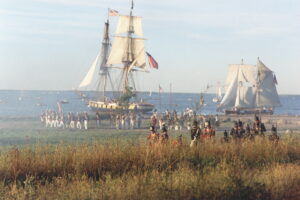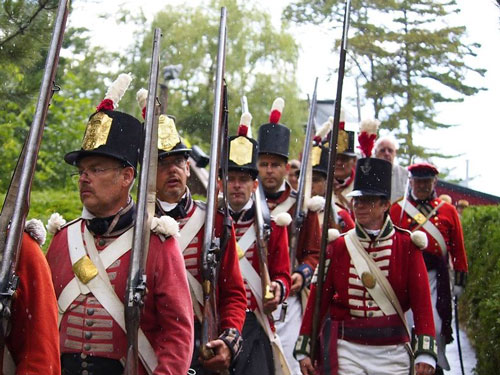This article was published in the Member’s Corner of the Simcoe County Historical Association’s Summer 2022 Newsletter and is reprinted here with their permission.
For a complete copy of their newsletter, click here. You will be redirected to their site and the specific newsletter.
By John Merritt,
Membership Chair, SCHA
For this edition of our Members’ Corner series, we will be featuring the Historic Military Establishment of Upper Canada (HMEUC), a group of passionate historical re-enactors who have helped educate the public about Simcoe County’s role in the War of 1812 for over 30 years. The HMEUC has been a member organization of the SCHA for over thirteen years.
In 1990, the Historic Military Establishment of Upper Canada (HMEUC) started modestly as a collection of a few historical enthusiasts that met as volunteers at the Historic Naval and Military Establishments (later renamed Discovery Harbour) in Penetanguishene.
Members were united by a common interest in re-enacting the military history of the War of 1812. It was decided that the group would portray soldiers of the Royal Newfoundland Regiment (RNR), circa 1795-1816.
For the founding members of the HMEUC, the choice to portray the
Royal Newfoundland Regiment was a simple one as this regiment
marched right through Simcoe County in 1814 on its way to relieve
the isolated British outpost on Mackinac Island in Lake Huron, establishing what is now known as Fort Willow on the way. Being natural sailors from Newfoundland, soldiers of the RNR also served on gunboats and ships during the War of 1812, which gave members of the HMEUC the opportunity to portray not just soldiers but also sailors and artillerymen.

To attract recruits, the newly founded HMEUC began offering costumed demonstrations at local Canada Day festivities, participating in re-enactments of War of 1812 battles, and providing public education at local schools, museums and historic sites, including Discovery Harbour, Nancy Island and Fort Willow.
As time went on, the HMEUC took part in many events across Simcoe County and began hosting its own events locally in order to draw other re-enactors to the area and create large-scale, tourism-based War of 1812 heritage events right here in Simcoe County. One of these events grew in popularity, culminating in “the Battle of Georgian Bay” in 2001, which featured 1,800 re-enactors, tall ships, and a large grand encampment at Discovery Harbour that portrayed War of 1812 camp life. The event returned to the area in 2019 when Discovery Harbour hosted that year’s War of 1812 Grand Tactical for North America.

As part of bicentennial commemorations of the War of 1812, the HMEUC received grant funding from the federal government to create a legacy project commemorating veterans of the War of 1812.
The resulting website, www.gravesideproject.ca, lists individual veterans and their biographies. Contributors can send in biographies of known War of 1812 veterans and, once approved, can receive a black granite plaque to mark the grave as being that of a War of 1812 veteran. To date, the project has compiled almost 400 biographies and distributed plaques across Ontario, Quebec and the Maritimes. The project marks the first time deceased War of 1812 veterans have been recognized for their service.
As the HMEUC has evolved over the years, it has continued to provide heritage programming across Simcoe County and the province of Ontario and as far away as Fort Meigs, Ohio. With the advent of Covid-19, this intrepid group of War of 1812 re-enactors has adapted to modern technology.
Their videos have been sent to events as far away as Sault Ste. Marie in order to continue to provide programming to the public despite the travel restrictions imposed by the pandemic.
Although its members are united by a love of historical re-enacting, the theme of education lies behind all their activities, and the aim of
the HMEUC is to bring history to life in an informative and enjoyable
fashion.
For more information on the HMEUC, please visit their website,
www.hmeuc.com.
Courtesy, Simcoe County Historical Association, Member’s Corner: The Historic Military Establishment of Upper Canada

